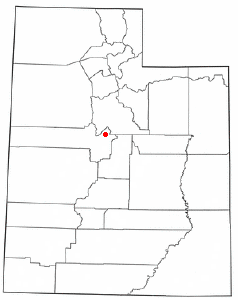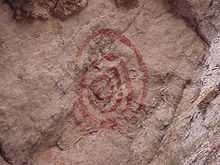Mona, Utah
| Mona, Utah | |
|---|---|
| City | |
 | |
 | |
| Coordinates: 39°48′55″N 111°51′23″W / 39.81528°N 111.85639°WCoordinates: 39°48′55″N 111°51′23″W / 39.81528°N 111.85639°W | |
| Country | United States |
| State | Utah |
| County | Juab |
| Settled | 1860 |
| Incorporated | 1924 |
| Became a city | April 1, 2001 |
| Named for | Isle of Man |
| Area | |
| • Total | 1.4 sq mi (3.7 km2) |
| • Land | 1.4 sq mi (3.6 km2) |
| • Water | 0.0 sq mi (0.1 km2) |
| Elevation | 4,970 ft (1,515 m) |
| Population (2000) | |
| • Total | 850 |
| • Density | 614.1/sq mi (237.8/km2) |
| Time zone | Mountain (MST) (UTC-7) |
| • Summer (DST) | MDT (UTC-6) |
| ZIP code | 84645 |
| Area code(s) | 435 |
| FIPS code | 49-51140[1] |
| GNIS feature ID | 1443548[2] |
Mona is a city in Juab County, Utah, United States. It is part of the Provo–Orem, Utah Metropolitan Statistical Area. The population was 850 at the 2000 census. At the time this was sufficient under Utah state law for Mona to become a city,[3] which it did in 2001.
It is about halfway between Santaquin and Nephi, about 1.6 km (1 mi) west of Interstate 15.
The town was originally settled as Clover Creek in 1852, then renamed to Willow Creek, then Starr, before receiving its present name. Burl Ives was once jailed in Mona for singing "Foggy Foggy Dew", because it was considered bawdy by the authorities.
One of the unique things about Mona is a farm growing lavender. 120 acres (0.49 km2) of lavender are planted on the north side of town.[4] Mona also has an annual Lavender Festival.
Geography

Mona is located at 39°48′55″N 111°51′23″W / 39.81528°N 111.85639°W (39.815392, -111.856354).[5]
According to the United States Census Bureau, the city has a total area of 1.4 square miles (3.7 km2), of which, 1.4 square miles (3.6 km2) of it is land and 0.04 square miles (0.1 km2) of it (2.82%) is water.
Mona is at the foot of Mount Nebo, the southernmost and highest mountain in the Wasatch Range.
Demographics
| Historical population | |||
|---|---|---|---|
| Census | Pop. | %± | |
| 1870 | 315 | ||
| 1880 | 503 | 59.7% | |
| 1890 | 469 | −6.8% | |
| 1900 | 469 | 0.0% | |
| 1910 | 467 | −0.4% | |
| 1920 | 408 | −12.6% | |
| 1930 | 338 | −17.2% | |
| 1940 | 357 | 5.6% | |
| 1950 | 328 | −8.1% | |
| 1960 | 347 | 5.8% | |
| 1970 | 309 | −11.0% | |
| 1980 | 536 | 73.5% | |
| 1990 | 584 | 9.0% | |
| 2000 | 850 | 45.5% | |
As of the census[1] of 2000, there were 850 people, 232 households, and 203 families residing in the town. The population density was 614.1 people per square mile (237.8/km2). There were 243 housing units at an average density of 175.5 per square mile (68.0/km2). The racial makeup of the town was 98.24% White, 0.35% Native American, 0.12% Asian, 0.12% from other races, and 1.18% from two or more races. Hispanic or Latino of any race were 1.41% of the population.
There were 232 households out of which 53.0% had children under the age of 18 living with them, 77.2% were married couples living together, 6.9% had a female householder with no husband present, and 12.1% were non-families. 9.9% of all households were made up of individuals and 6.0% had someone living alone who was 65 years of age or older. The average household size was 3.66 and the average family size was 3.97.
In the town the population was spread out with 40.7% under the age of 18, 10.2% from 18 to 24, 25.4% from 25 to 44, 16.6% from 45 to 64, and 7.1% who were 65 years of age or older. The median age was 24 years. For every 100 females there were 95.0 males. For every 100 females age 18 and over, there were 96.1 males.
The median income for a household in the town was $49,464, and the median income for a family was $50,625. Males had a median income of $35,982 versus $22,222 for females. The per capita income for the town was $14,474. About 0.5% of families and 2.4% of the population were below the poverty line, including 2.3% of those under age 18 and none of those age 65 or over.
References
- ↑ 1.0 1.1 "American FactFinder". United States Census Bureau. Retrieved 2008-01-31.
- ↑ "US Board on Geographic Names". United States Geological Survey. 2007-10-25. Retrieved 2008-01-31.
- ↑ Trauntvein, Myrna (December 9, 2000). "Mona is now a third-class city". Deseret News. p. A18. Retrieved June 17, 2009.
- ↑ Young Farms Lavender Farm
- ↑ "US Gazetteer files: 2010, 2000, and 1990". United States Census Bureau. 2011-02-12. Retrieved 2011-04-23.
 |
Eureka | Goshen, Rocky Ridge | Elk Ridge |  |
| Fish Springs National Wildlife Refuge | |
Scofield | ||
| ||||
| | ||||
| Leamington | Nephi | Fountain Green, Fairview |
| ||||||||||||||||||||
